Transitioning your e-commerce store to Magento can seem daunting, especially with its robust features and intricate architecture. However, with the right strategies, you can overcome the perceived complexity and enjoy the vast benefits this powerful platform offers. Whether you’re switching from WooCommerce, Shopify, or another platform, this guide will help simplify your move to Magento and ensure a seamless transition.
Why Move to Magento?
Magento powers over 12% of all e-commerce websites worldwide, making it a trusted solution for businesses of all sizes. It offers unmatched flexibility, scalability, and customization options, making it ideal for growing businesses. Here are some key reasons to move to Magento:
- Customizability: Tailor your store to meet specific business needs.
- Scalability: Handle high traffic and large product catalogs effortlessly.
- Robust Features: Access advanced features like multi-store management, layered navigation, and powerful analytics.
- SEO-Friendly: Benefit from built-in SEO tools to improve search engine rankings.

Step 1: Plan Your Migration Strategy
A well-thought-out migration plan is crucial for a successful move to Magento. Identify your goals and outline a clear roadmap.
Key Considerations:
- Data Migration: What data needs to be transferred? Products, customers, orders, and content are essential.
- Design: Decide whether to retain your current design or create a new one.
- Extensions: List essential extensions to replicate or improve functionality.
- Timelines: Set realistic deadlines for each stage of the migration.
Use a migration checklist to ensure no details are overlooked.
Step 2: Choose the Right Magento Edition
Magento offers two editions: Magento Open Source and Adobe Commerce (formerly Magento Commerce). Selecting the right one depends on your business requirements.
- Magento Open Source: Ideal for small to medium-sized businesses with technical expertise.
- Adobe Commerce: Suitable for enterprises needing advanced features like customer segmentation, B2B functionality, and cloud hosting.
Evaluate your budget, scalability needs, and desired features to make the best choice.
Step 3: Optimize for Performance
Magento’s powerful capabilities can be resource-intensive, so optimizing your store’s performance is essential.
Tips for a Fast Magento Store:
- Use a VPS or Dedicated Server: Avoid shared hosting for better speed and reliability.
- Enable Caching: Use built-in caching mechanisms like Full Page Cache (FPC).
- Optimize Images: Compress images without compromising quality.
- Use a CDN: A Content Delivery Network reduces latency and speeds up content delivery.
Google research shows that 53% of mobile users abandon sites that take longer than 3 seconds to load. Speed optimization is non-negotiable.
Step 4: Simplify Data Migration
Data migration can be one of the most challenging aspects of moving to Magento, but tools and best practices can simplify the process.
Recommended Tools:
- Magento’s Data Migration Tool: Official tool for migrating from Magento 1 to Magento 2.
- Third-Party Services: Tools like Cart2Cart or LitExtension support migrations from other platforms like WooCommerce and Shopify.
Best Practices:
- Back up your data before migration.
- Validate data to ensure accuracy.
- Test the migration process on a staging environment before going live.
Step 5: Customize Your Store Design
Your store’s design plays a significant role in customer experience. Magento offers flexibility to create a unique and user-friendly design.
Tips for Effective Design:
- Choose a Responsive Theme: Ensure your store looks great on all devices.
- Prioritize User Experience (UX): Use clear navigation, fast-loading pages, and intuitive layouts.
- Leverage Magento’s Customization Capabilities: Modify themes and layouts to reflect your brand identity.
Step 6: Install Essential Extensions
Enhance your store’s functionality by installing extensions tailored to your business needs. Some popular categories include:
- SEO Tools: Improve your site’s visibility on search engines.
- Payment Gateways: Integrate options like PayPal, Stripe, or Authorize.net.
- Marketing Tools: Use extensions for email campaigns, loyalty programs, and upselling.
Choose extensions from trusted developers to avoid compatibility and performance issues.
Step 7: Focus on SEO and Marketing
Moving to Magento is an excellent opportunity to improve your store’s SEO and marketing strategies. According to BrightEdge, 68% of online experiences begin with a search engine.
SEO Tips:
- Use Magento’s built-in SEO features like metadata, XML sitemaps, and URL rewrites.
- Optimize product descriptions and images.
- Implement structured data to enhance search engine visibility.
Marketing Tips:
- Set up email campaigns using tools like Mailchimp.
- Use Google Analytics and Google Tag Manager for data-driven decisions.
- Create promotional offers to attract and retain customers.
Step 8: Test and Launch Your Store
Before going live, thoroughly test your store to ensure everything works seamlessly. Create a checklist covering:
- Functional testing: Verify that all features, from search to checkout, are working correctly.
- Performance testing: Ensure your store loads quickly under various conditions.
- Cross-browser compatibility: Test your site on popular browsers and devices.
Once testing is complete, you’re ready to launch your Magento store.
Step 9: Monitor and Maintain Your Store
Post-launch, regular maintenance is crucial to keep your store running smoothly. Monitor performance, update extensions, and ensure security measures are up-to-date. Magento’s flexibility allows for continuous improvement, so stay proactive to meet evolving customer needs.
Conclusion
The decision to move to Magento can transform your e-commerce business by offering enhanced features, scalability, and customizability. By following these simple solutions, you’ll overcome the complexity and set your store up for success.

